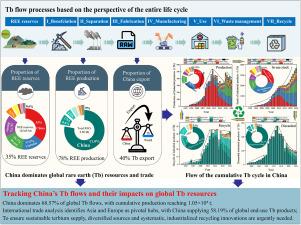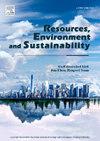追踪中国的铽代谢及其在全球稀土供应中的主导地位
IF 7.8
Q1 ENVIRONMENTAL SCIENCES
引用次数: 0
摘要
铽(Tb)是一种重要的重稀土元素,由于其在绿色技术中不可替代的作用和地缘政治供应链的复杂性,其供需失衡日益加剧。为了探索结核病的可持续发展途径,本研究建立了一个时空明确的物质流分析框架,以绘制结核病在中国社会经济系统(1990-2024)和全球贸易网络中的生命周期动态。结果显示,亚洲和欧洲是关键枢纽,其中中国占全球Tb流量的68.57% (1.05 × 104 t),主要流向荧光粉(2007年达到峰值74.5%)和永磁体(2021年后占90%)。从历史上看,结核病流量与工业产品周期密切相关。从1990年到2024年,大约有1.16 × 104吨的Tb被开采并加工成各种最终用途产品。荧光灯历来是主要的最终用途;但从2014年开始,永磁体占据先机,2024年占市场流量的90%,其次是新能源技术和家用电器。新能源领域的需求预计将超过家用电器的需求,成为消费的主要推动力。因此,结核病回收潜力最大的是荧光灯和家用电器,它们将占2023年总回收的63%。然而,迫切需要积极发展系统回收产业,以应对即将到来的报废产品激增,如风力涡轮机和新能源汽车。为了实现结核病的全球可持续性,技术加速途径迫切需要多样化的供应来源和工业规模回收方面的创新。本文章由计算机程序翻译,如有差异,请以英文原文为准。

Tracking terbium metabolism in China with implications for its dominance in global rare earth supply
Terbium (Tb), a critical heavy rare earth element, faces intensifying supply–demand imbalances driven by its irreplaceable role in green technologies and geopolitical supply chain complexities. To explore sustainable pathways for Tb, this study establishes a spatially and temporally explicit material flow analysis framework to map Tb’s life cycle dynamics across China’s socioeconomic systems (1990–2024) and global trade networks. Results reveal that Asia and Europe as pivotal hubs, with China dominating 68.57% (1.05 × 104 t) of global Tb flows, primarily channeled into phosphors (peaking at 74.5% in 2007) and permanent magnets (90% of post-2021. Historically, Tb flows have been closely tied to industrial product cycles. From 1990 to 2024, approximately 1.16 × 104 t of Tb were mined and processed into various end-use products. Fluorescent lamps were historically the dominant end use; however, since 2014, permanent magnets have become precedence, accounting for 90% of the market flow in 2024, followed by new energy technologies and household appliances. Tb demand in the new energy sector is expected to exceed that of household appliances and become the main driver of consumption. Therefore, the most significant potential for Tb recovery resides in fluorescent lamps and home appliances, which account for 63% of total recovery in 2023. However, an urgent imperative exists for the proactive development of systematic recycling industries to address the imminent surge in end-of-life products such as wind turbines and new energy vehicles. To achieve global sustainability of Tb, technology-accelerated pathways urgently require diversified supply sources and innovations in industrial-scale recycling.
求助全文
通过发布文献求助,成功后即可免费获取论文全文。
去求助
来源期刊

Resources Environment and Sustainability
Environmental Science-Environmental Science (miscellaneous)
CiteScore
15.10
自引率
0.00%
发文量
41
审稿时长
33 days
 求助内容:
求助内容: 应助结果提醒方式:
应助结果提醒方式:


